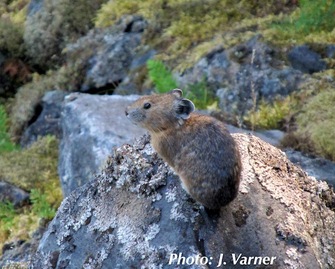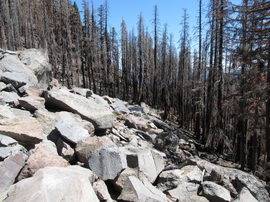My research centers on the American Pika (Ochotona princeps), a small mammalian herbivore that is closely related to rabbits and hares. Pikas are typically restricted to rock-slides and boulder fields at high elevations. Because of their sensitivity to heat stress and limited ability to disperse between patches of habitat, they may also be indicators of alpine ecosystem health in response to climate change.
Below is a list of my current research projects.
Below is a list of my current research projects.
Pika ecology in atypical, low elevation habitat

Despite an apparent reliance on cold climates, pikas thrive near sea level in the warm temperate rainforests of the Columbia River Gorge, Oregon.
My PhD dissertation research focused on ecological factors that promote pika persistence in this atypical habitat. Specifically, I investigated how these animals have adapted foraging and thermoregulatory strategies to survive in a climate that appears to be unsuitable. The results of this study will help redefine critical habitat factors for pika survival and elucidate the species' capacity for adapting to new climates.
Along with collaborators, I am now extending some of these studies to other atypical habitats, including lava-dwelling pikas in Idaho and isolated populations in Colorado and Utah.
My PhD dissertation research focused on ecological factors that promote pika persistence in this atypical habitat. Specifically, I investigated how these animals have adapted foraging and thermoregulatory strategies to survive in a climate that appears to be unsuitable. The results of this study will help redefine critical habitat factors for pika survival and elucidate the species' capacity for adapting to new climates.
Along with collaborators, I am now extending some of these studies to other atypical habitats, including lava-dwelling pikas in Idaho and isolated populations in Colorado and Utah.
Pika survival and recolonization after forest fire

In September 2011, the Dollar Lake fire burned over 6,000 acres on Mt. Hood, including several locations where I had been observing pikas. As a result, I have a unique opportunity to study the temperatures in a rock-slide before, during, and after a major fire. I am also monitoring pika survival at many patches of habitat and testing hypotheses about recolonization of the most severely burned areas.
In addition, I am collaborating with Cascades Pika Watch and the USFS to monitor pika survival and recolonization following the 2017 Eagle Creek Fire in the Columbia River Gorge.
You can learn more about Cascades Pika Watch and volunteer here.
In addition, I am collaborating with Cascades Pika Watch and the USFS to monitor pika survival and recolonization following the 2017 Eagle Creek Fire in the Columbia River Gorge.
You can learn more about Cascades Pika Watch and volunteer here.
